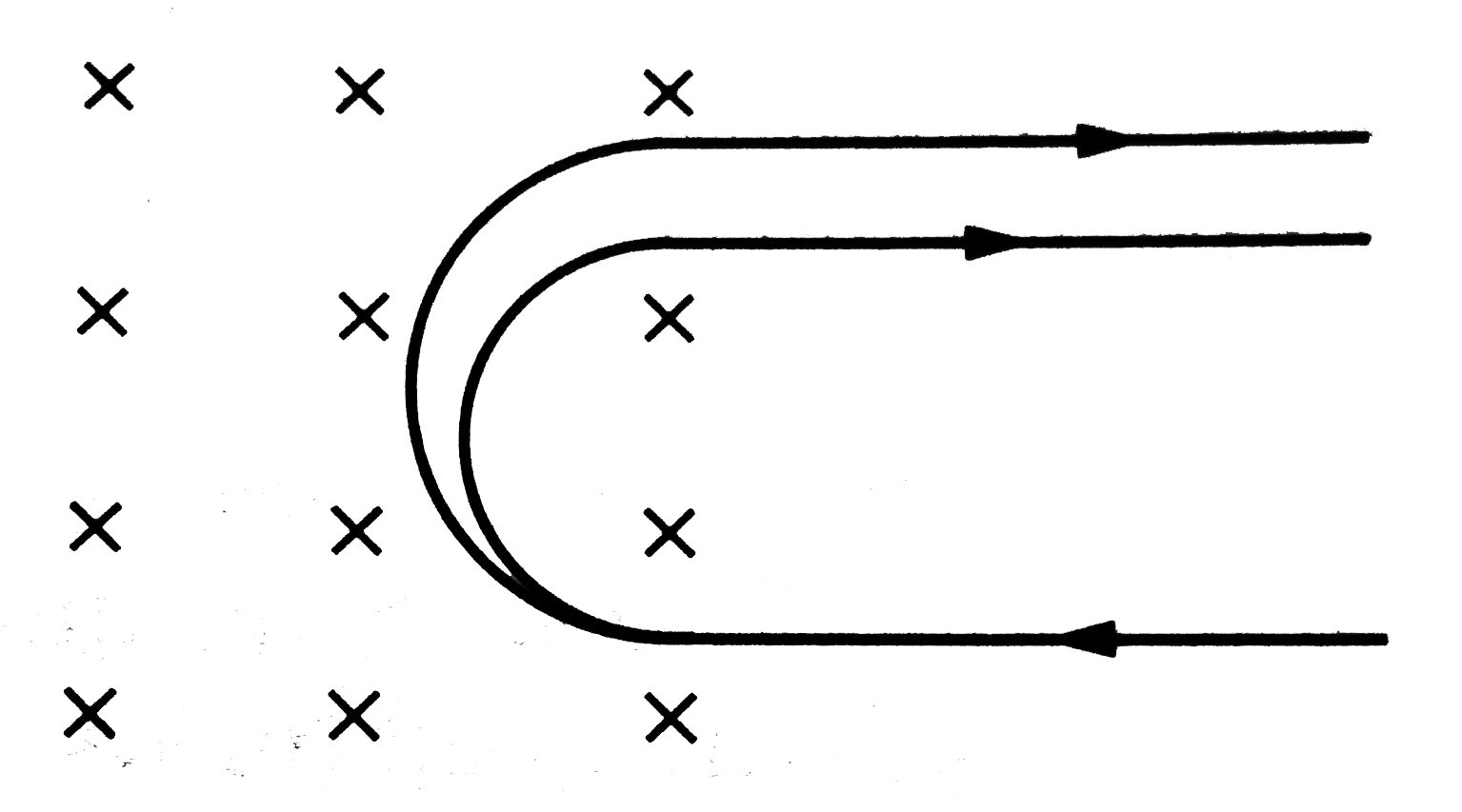A narrow beam of singly charged carbon ions, moving at a constant velocity of 6.0X104ms−1, is sent perpendicularly in a rectangular region having uniform magnetic field B=0.5 T . It is found that two beams emerge from the field in the backward derection, the separations from the incident beam being 3.0 cm and 3.5cm. Identify the isotopes persent in the ion beam. Take the mass of an ion = A(1.6X10−27 kg, where A is the mass number.
 Solution in Tamil
Solution in Tamil
u=6×104ms,B=0.5T ,
⇒r1=32=1.5cm,r2=352cm
⇒r1=μqB
rArr 1.5×10−2=(m1×6×1046×1.6×10−10×0.5
⇒m1=1.2×10−36
=12×10−36
Hence carbon ratine = 2 (for carbon )
The laolopes used are ^(12)C _(0) and ^(14)C
Topper's Solved these Questions
Similar Questions
If a charged particle at rest experiences no electromagnetic force, then electric field in that region
02:20View SolutionFind the range of frequency of light that is visible to an average human being (400nm<λ<700nm)
View SolutionUsing the formulae ((→F)=(→qv)×(→B)andB=(μ0)i2πr,find the SI units of the magnetic field B and the permeability constant
05:03View SolutionProtons having kinetic energy K emerge from an accelerator as a narrow beam. The beam is bent by a perpendicular magnetic field so that it just misses a plane target kept at a distance I in front of the accelerator. Find the magnetic field.
02:35View SolutionA nerrow beam of singly charged potassium ions of kinetic energy 32keV is injected into a region of width 1.00 cm having a magnetic field of strenght 0.500 T as shown in . The ions are collected at a screen 95.5cm away from the field region. If the beam contains isotopes of atomic weights 39 and 41, find the separaton between the points where these isotopes strike the screen. Take the mass of a potassium ion=A(1.6X10−27 kg where A is the mass number.
 03:26View Solution
03:26View SolutionA light beam, passes from medium 1 to medium 2. Show that the emerging beam is parallel to the incident beam.
07:49View SolutionA 1μA beam of protons with a cross - sectional area of 0.5sq.mm is moving with a velocity of 3×104ms−1 . Then charge density of beam is
02:05View SolutionA long uniform cylindrical beam of radius R consists of positively charged particles each of charge q, mass m and velocity V along positive x direction. The axis of the beam is the x-axis. The beam is incident on a region having magnetic field in y-z plane. The magnetic field in the region is confined to 0lexleDeltax(Deltax "is small"). The field lines are circular in yz plane as shown. The magnitude of the field is given by B = B_(0) r where B_(0) is a constant and r is distance from the origin. Show that this magnetic field acts as a converging lens for the ion beam and obtain the expression for focal length. Neglect the divergence in the beam caused due to electromagnetic interaction of the charge particles.
04:16View SolutionA long, narrow beam of electrons, of uniform cross-section consists of electrons moving with velcity v ( c= velocity of light ). The ratio of the electric field to the magnetic field at any point near the beam is
04:39View SolutionA light beam passes from medium 1 to medium 2. Show that the emerging beam is parallel to the incident beam.
03:27View Solutionप्रश्न 16 में वर्णित हेल्म्होल्ट्ज कुंडलिया का उपयोग करके किसी लघुक्षेत्र में 0.75 t का सामान चुंबकीय क्षेत्र स्थापित किया है। इसी क्षेत्र में कोई एकसमान स्थिरवैघुत क्षेत्र कुंडलियों के उभयनिष्ट अक्ष के लंबवत लगाया जाता है। (एक ही प्रकार के) आवेशित कणों का 15 kV विभवांतर पर त्वरित एक संकीर्ण किरण पूंज इस क्षेत्र में दोनों कुंडलियों के अक्ष तथा स्थिरवैद्युत क्षेत्र की लंबवत दिशा के अनुदिश प्रवेश करता है। यदि यह किरण पुंज 9.0×10−5Vm−1. स्थिरवैद्युत क्षेत्र में अविक्षेपित रहता है तो या अनुमान लगाइये कि किरण पुंज में कोण से कण है। यह स्पष्ट कीजिये कि यह उत्तर एकमात्र उत्तर क्यों नहीं है।
05:21View SolutionAn uniform beam of positively charged particles is moving with a constant velocity parallel to another beam of negatively charged particles, velocity in opposite direction separated by a distance d the variation of magnetic field B along a perpendicular line draw between the two beams is best represented by
04:10View SolutionA beam of protons enters a uniform magnetic field of 0.314 T with a velocity 4xx10^(5) ms^(-1) in a direction making an angle 60^(@) with the direction of the magnetic field. The path of the beam is (mass of proton = 1.6xx10^(-27) kg)
05:00View SolutionTwo types of particles having same charge equal to +2e but different masses are moving with a constant velocity of 6 xx 10^(4) m/s in the form of a beam. These particles suddenly encounter a perpendicular magnetic field in a rectangular region having intensity equal to 0.5 T. It is found that particles emerge from the field in the backward direction from two different points. These points are at a distance 3 cm and 3.5 cm from the incident beam. Find the ratio of their masses.
03:30View SolutionA beam of protons with a velocity of 4X105ms−1 enters a uniform magnetic field of 0.3 T. The velocity makes an angle of 60∘ with the magnetic field. Find the radius of the helical path taken by the proton beam.
02:19View SolutionProtons having kinetic energy K emerge from an accelerator as a narrow beam. The beam is bent by a perpendicular magnetic field so that it just misses a plane target kept at a distance I in front of the accelerator. Find the magnetic field.
03:09View Solution

